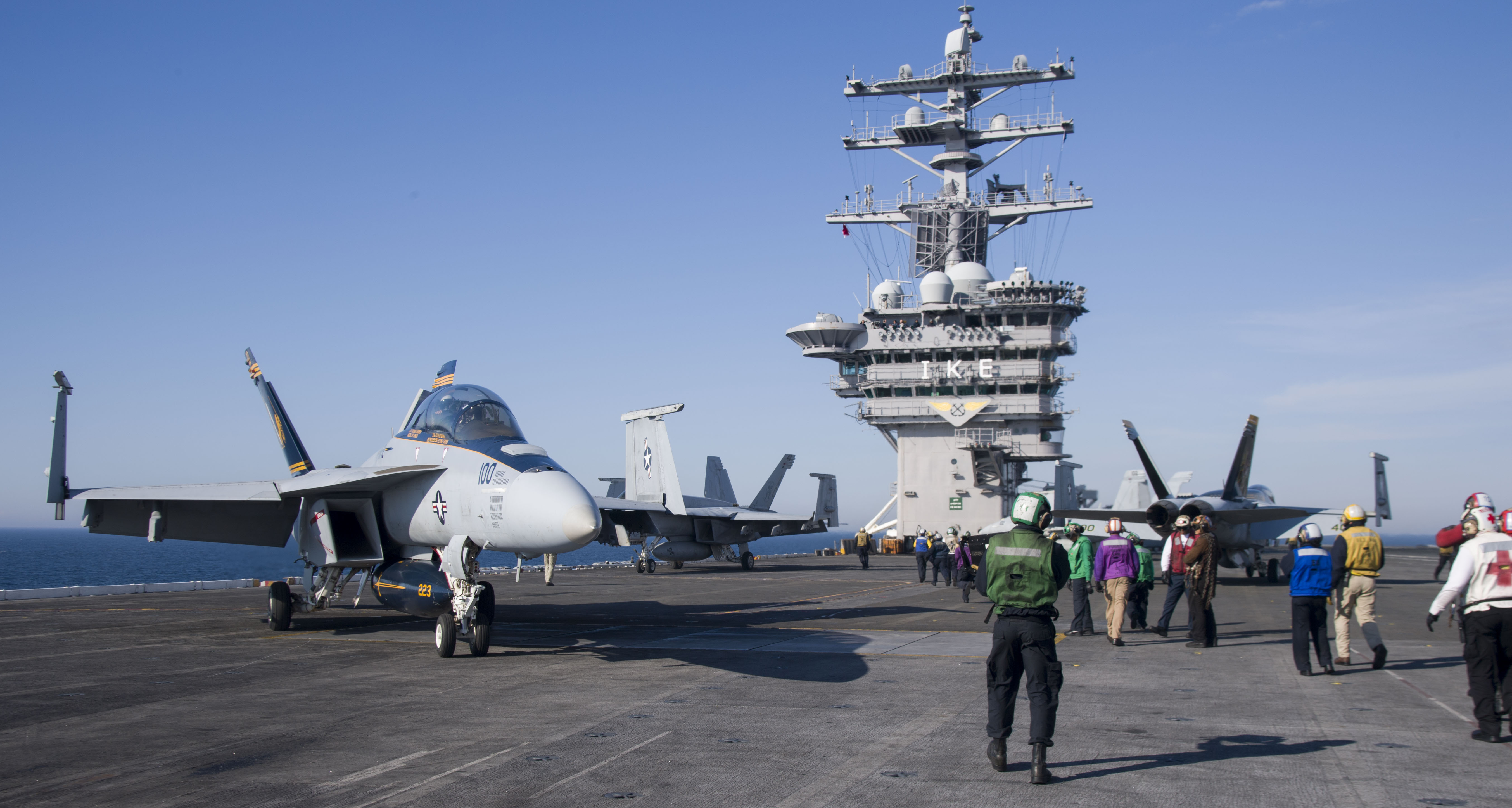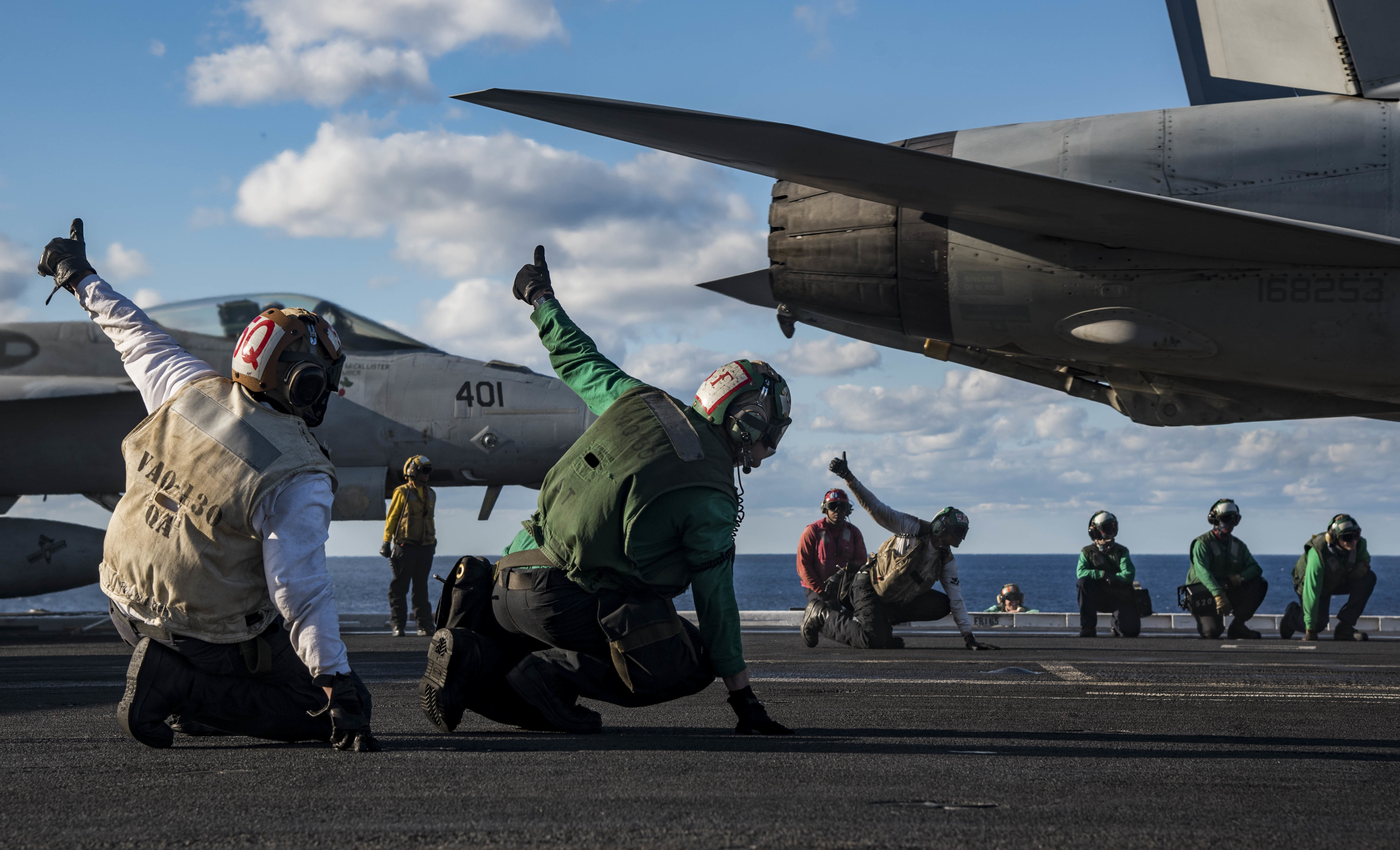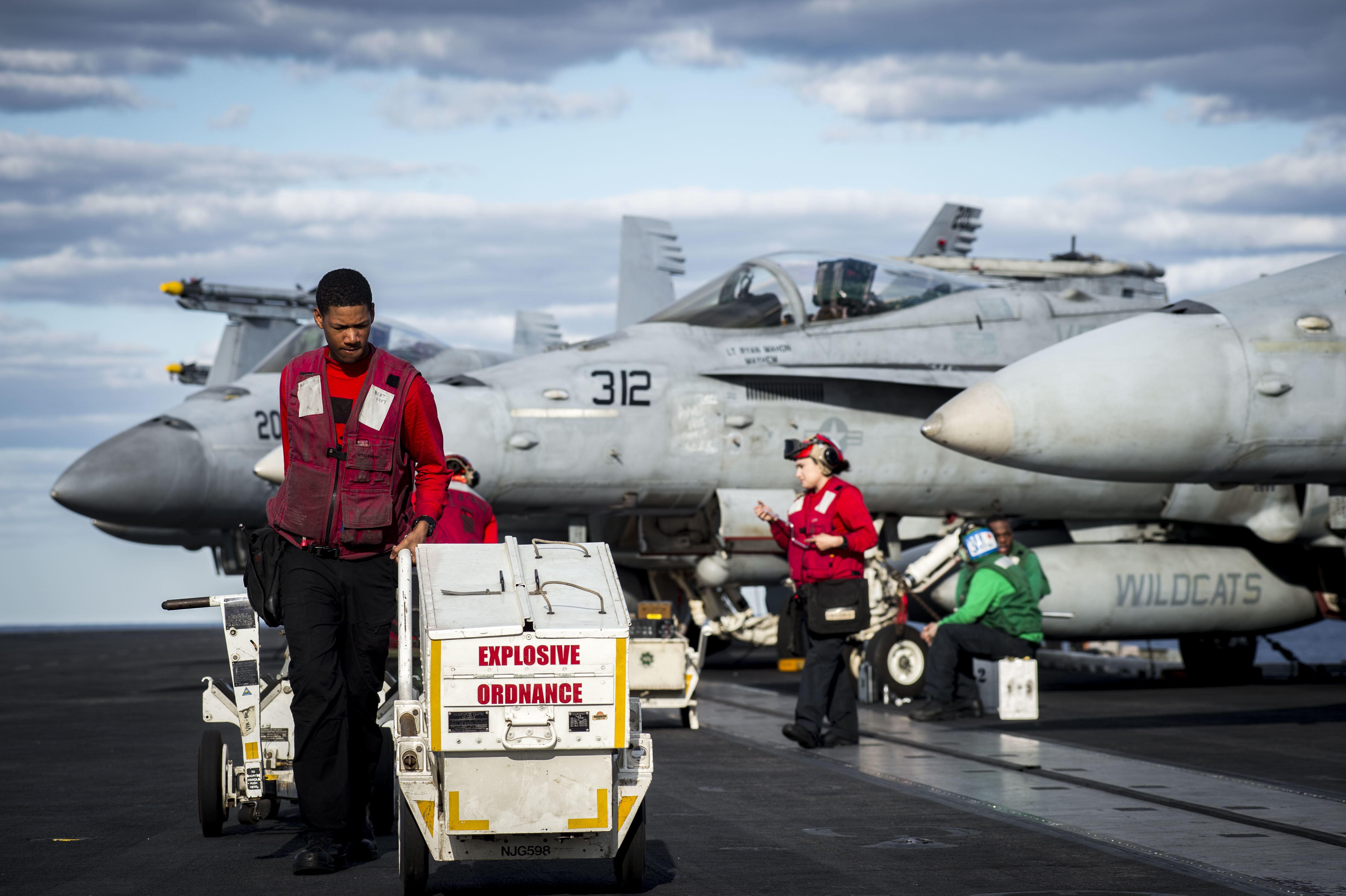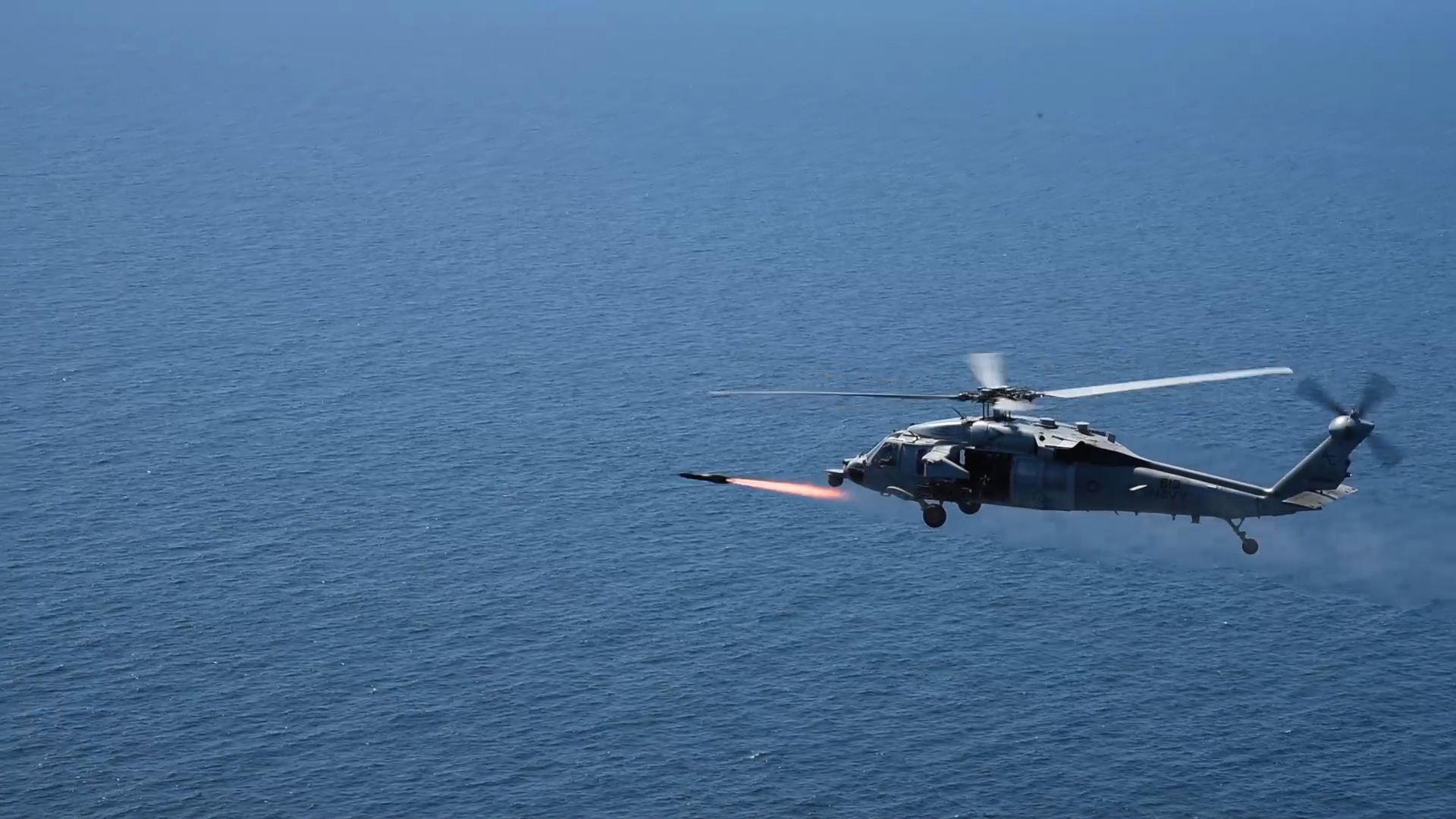
This article is the second in a two-part package on the East Coast aircraft carrier fleet, after Commander of Naval Air Force Atlantic Rear Adm. Bruce Lindsey invited USNI News to talk about recent milestones within his fleet.
NAVAL STATION NORFOLK, Va. — Maintaining very high readiness during a carrier strike group’s post-deployment sustainment phase actually saves the Navy money later on, the service found, despite fears that budget constraints might hinder the Navy from making the most of that time in a ship’s deployment cycle.
Under the Navy’s Optimized Fleet Response Plan, a ship undergoes routine maintenance and modernization, conducts pre-deployment workups, deploys overseas, and then comes home for a “sustainment phase” of as long as a year before heading back to the shipyard for more maintenance. Carrier strike groups in the sustainment phase could be sent back overseas for a full-length deployment in a major contingency, used locally for training, sent to respond to natural disasters if needed, or whatever the Navy and Joint Chiefs tasked it to do.
When OFRP was rolled out and first implemented, Navy officials and observers alike worried that the sustainment phase wouldn’t be properly funded and noted that the Navy had a poor track record of funding ships post-deployment. Under the Budget Control Act, the operations and maintenance budget has been a major bill-payer for other needs, and ships just back from deployment could be especially vulnerable to budget cuts, they worried.
With OFRP now in full swing in the East Coast aircraft carrier fleet, Commander of Naval Air Force Atlantic Rear Adm. Bruce Lindsey said he received the funding needed to keep USS Dwight D. Eisenhower (CVN-69) highly maintained and its crew highly trained during its sustainment phase earlier this year, and that those investments are now paying off as the carrier heads into maintenance at Norfolk Naval Shipyard.

“We maintained her at a very high readiness level. Ready to deploy, should the national command authorities or the [chief of naval operations] or anybody above me say I need that ship to do this. And so she was ready to go January, February, March, April, May, June and July; when she comes back she’ll enter the maintenance phase after seven months of very high support,” Lindsey told USNI News last month in an interview in his office.
“There was no a casualty report or system on there that we did not go after and fix – usually with the help of Norfolk Naval [Shipyard], if it was a big job, or the MARMC (Mid-Atlantic Regional Maintenance Center) here, maintenance facility here. So again, her readiness is as good or better than any deployed carrier out there. And the air wing was too. So that actually, when you keep the ship at a high state of readiness, when you come in for the planned incremental (availability), you haven’t thrown all these extra jobs into the work package there.”
“In the long run, spending a little bit of money like this actually saves you money. A lot of times we can’t do that with the way our budget is,” Lindsey noted, but said that U.S. Fleet Forces Command prioritized this funding even during a continuing resolution to make sure Eisenhower remained at peak readiness.
Because Eisenhower could have been called to deploy during its sustainment phase, Lindsey said he ensured it was being manned and maintained with that potentiality in mind.
“I treated them as if they were out on deployment. So whenever anything broke, we were right on it fixing it,” he said.
“And then we also manned them, kept the manning all the way though (the sustainment phase), so that if they were called, they were at that highest readiness level.”

On the training side, Lindsey said the carrier strike group commander oversaw training leading up to and after a Sustainment Exercise (SUSTEX) to ensure the ship’s and air wing’s crews were sharp. The IKE Carrier Strike Group returned from its deployment on Dec. 30, 2016, and had an easy schedule in January for crew rest. But beginning in February, IKE CSG commander Rear Adm. James Malloy and the training group Carrier Strike Group 4 worked together to develop a rigorous training plan.
“The strike group commander says, I know my strike group best. I know what we did here (during deployment), and this was a lot of air-to-ground, but I didn’t do a lot of air-to-air, and I didn’t do a lot of war at sea, and I didn’t defend myself against missiles,” Lindsey explained.
“Whatever he knows best. So he works with the commander of Strike Group 4 to develop a scenario (for SUSTEX) that will get him the training that he needs. … They did a live missile ex, shooting I think at supersonic targets with jamming and all high-end types of things here, to do that, the missile shot. And he did a lot of air-to-air fighting, both live, but we also inserted virtual. So now the man on the scope sees five aircraft coming in, but there’s only one real one coming in for our guys to fight against. … And he will see missiles coming in, constructive missiles. So we are pushing our live, virtual, constructive (LCV) – that’s how we are accelerating along here (the capability curve).”
“We put that investment into [LVC opportunities] and that got their training up, and their readiness ratings were all green,” Lindsey said of the IKE CSG’s sustainment phase.

Of course this high level of readiness had an upfront cost. Lindsey praised U.S. Fleet Forces Command commander Adm. Phil Davidson and his staff for the “maneuvers” it took to keep Eisenhower funded during the sustainment phase, saying “I never wanted for money that I needed to keep them at that high level. … That’s a testament to Adm. Davidson and his staff, his comptroller and everything.”
Still, the aircraft carrier’s readiness is only one piece of the puzzle. Lindsey said the carrier was fully funded, and the air wing’s Flight Hour Program account was fully funded, but that shortfalls in areas like supplies and logistics led to airplanes that were not properly maintained and therefore could not fly. He urged the same devotion to fully funding these enabler accounts as the Navy and lawmakers have shown to ship maintenance and flying hours.





